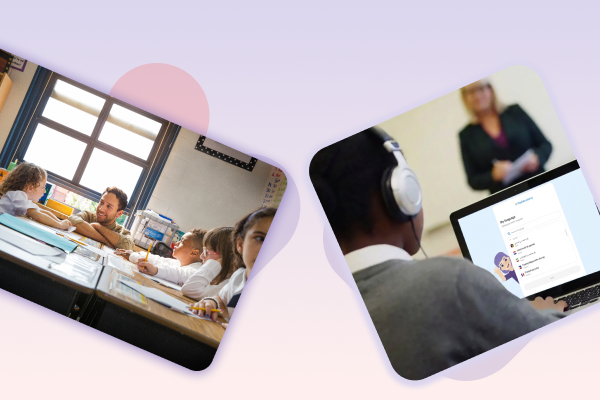

The language learning myths we hear in the world around us affect our attitude towards language learning. In the webinar on Language Awareness for Curriculum Teachers, we went into detail about why the following language learning myths are not true, despite being so prevalent.
Making children speak more than one language will confuse them.
Research shows that bilingualism has long-term advantages including increased cognitive control and improved problem-solving abilities. Recent research also suggests that languages are linked by a central processing unit within the brain. This helps the transfer of concepts from one language to another. Parents often believe this language learning myth and feel they should speak to their children in English all the time. In fact, it is better for parents to speak their home language as they are likely to be more confident and will give children richer language input.
EAL children should skip MFL lessons for extra English.
It is common for EAL pupils to be withdrawn from MFL to work on their English. However, in MFL lessons, there is usually a high level of visual input and translation. This supports pupils to learn English vocabulary alongside the MFL. They may receive more explicit grammar teaching and develop metalinguistic skills. Modern foreign languages may be more like pupils’ home languages and easier for them to learn than English, which can increase pupils’ confidence and provide more opportunities to succeed. Some pupils may have spent time in a country where that language is spoken, so if we withdraw pupils from MFL we may prevent them from developing existing skills.
If children can speak confidently, their work in class should be good.
You may see pupils chatting happily with friends, yet their work in class doesn’t seem to reflect their skills. Pupils need to develop different types of language, known as BICS (Basic Interpersonal Communication Skills) and CALP (Cognitive Academic Language Proficiency). BICS is usually spoken, informal language, and develops more quickly and easily than CALP, which we use to complete formal academic tasks. Pupils need extra support in order to become competent in academic language (whether they’re EAL or not!).
If a child isn’t speaking, their English level is very low.
Most EAL pupils go through a ‘silent phase’ when they first arrive as they absorb language through receptive skills of listening and reading. It will take time for them to produce language confidently or spontaneously, but their understanding may be higher than it seems. Help develop their confidence and provide structured tasks at their level. Some EAL pupils may be suffering from trauma or culture shock, which can have an impact on how much and to whom they speak. There may also be underlying additional needs which have not yet been diagnosed.

It is English teachers’ job to teach English
It is every teacher’s responsibility to support language development for all pupils. Awareness of learners’ language needs helps remove barriers to learning and create a more inclusive classroom. Consider which BICS and CALP learners will encounter in your lessons and how you will support learners to overcome related challenges. Remember, pupils with English as their first language are also disadvantaged by the word gap.
It is harder for older children to learn a second language
This is a very common language learning myth. It is true that young learners may become more fluent in a second language in the long-term. However, there are fewer demands on language for younger learners as they don’t have to use CALP and they are developing English skills alongside their peers. Older learners are often more efficient and make faster progress but are expected to cope with more complex CALP. Increased linguistic demands associated with age cause difficulties – not age itself.
A child isn’t making progress because of their low English level
English level may initially impact the amount of progress a pupil is making in comparison to their peers within a subject. However, research shows that EAL pupils actually make more progress and achieve higher academically than their English as a first language peers in the long-term. More recently arrived pupils may be making progress in BICS or speaking skills which we are not measuring in typical assessment tasks. Their English level may not be the only reason they are not making ‘progress’. Background always plays a role, so make sure you take into account prior education, home lives and possible SEN.
There is no published research on the average speed of progress we should expect from EAL pupils in their classwork. It’s usually said that it takes seven years to develop language fluency, but this doesn’t take into account the context of EAL pupils. Comparison within a group of EAL peers can also be difficult. Differences in learner language backgrounds could influence progression, and first language interference can produce different types of errors. For more information on ways that first languages can affect English language learning, have a look at these learner profiles.
It is not necessary to teach language explicitly if everyone in the class has the same first language
First-language English speakers may make more grammatical errors as they have often not had grammar rules explained to them. In addition, some pupils will need support with SLCN. Subject-specific (Tier Three) vocabulary needs to be taught explicitly as students are unlikely to come across it in their daily life. Pupils may also not encounter as much Tier Two vocabulary as they need, especially if they do not read widely. All learners will need to be introduced to these like a foreign language, taking into account definitions, context and connotations. Watch this Wow Words video and see how many Tier 2 words you can use to describe what’s happening. You can check your answers at the end!
For more details on these language learning myths and other aspects of language awareness for curriculum teachers, check out the webinar recording here.

